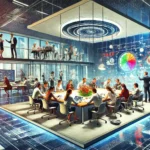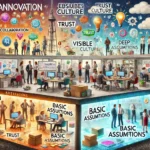Have you ever been in a business meeting where a certain issue seemed crystal clear to you, but the moment someone else shared their perspective, you realized they saw it in a completely different way?
This phenomenon ties back to a crucial aspect of organizational behavior: Perception.
Perception and decision-making are two inseparable elements of individual behavior that significantly impact interactions, productivity, and even the overall success of teams within organizations.
Let’s dive deeper into these two fascinating concepts.
Perception: How Do We See the World?
Perception is the mental process through which we analyze and interpret the information we receive from our surroundings.
Often, what we see or hear is not an exact representation of reality, but rather our interpretation of that information.
This means that two people can look at the same situation and have completely different understandings of it.
How is Perception Formed?
- Past Experiences:
What we have seen or experienced before shapes how we interpret new information.
For example, if we have previously worked on a similar project, we might perceive a new, similar project in a more positive light. - Culture and Beliefs:
The values and beliefs we’ve learned throughout life influence how we interpret information.
For instance, some cultures emphasize teamwork, while others value individual independence more. - Emotional State:
When we’re happy, we tend to see things in a more positive light. However, when we’re tired or frustrated, we may interpret situations more negatively.
Challenges of Perception in Organizations
- Cognitive Biases:
Sometimes, our minds distort information, leading to biased interpretations.
For example:- Halo Effect: When one positive trait (such as friendliness) causes us to perceive all other traits of a person positively.
- Anchoring Bias: When our decision is influenced by initial information, even if it is incomplete.
- Misunderstandings:
Because perception varies from person to person, workplace misunderstandings are common.
For example, a manager might give simple feedback, but the employee might interpret it as harsh criticism.
Decision-Making: The Art of Choosing the Best Option
Decision-making is the process of selecting the best choice among multiple alternatives.
Good decisions can lead to project success, while poor decisions can create significant challenges for an organization.
Steps of Decision-Making:
- Identifying the Problem:
For example, realizing that team productivity has declined. - Gathering Information:
Analyzing why the issue has occurred—Is it due to excessive stress? Lack of resources? - Exploring Alternatives:
Listing possible solutions, such as providing more training or implementing motivation programs. - Choosing the Best Option:
Selecting the solution that will yield the best outcome. - Implementation:
Executing the decision. - Evaluating the Outcome:
Reviewing whether the decision led to the desired results.
Factors Affecting Decision-Making
- Emotions:
Emotions, whether positive or negative, influence our decisions.
For example, when we are angry, we might make quick decisions without fully analyzing the details. - Available Information:
Incomplete information can lead to poor decisions.
This highlights the importance of thorough data collection. - Organizational Culture:
Some organizations encourage collaborative decision-making, while others centralize decision-making among managers. - Time:
When decisions are rushed, the likelihood of making mistakes increases.
The Connection Between Perception and Decision-Making
Perception and decision-making are directly linked.
- If our perception of an issue is flawed, we are more likely to make the wrong decision.
- For instance, if a manager misjudges an employee’s performance, they might make a poor decision about their promotion.
How to Improve Perception and Decision-Making?
- Awareness of Biases:
Understanding that our minds sometimes distort information helps us make better decisions. - Collecting Accurate Information:
The more information we have, the more logical and effective our decisions will be. - Seeking Feedback:
Asking colleagues or team members for their perspectives on our decisions. - Practicing Critical Thinking:
Evaluating all options carefully and predicting potential outcomes leads to better decision-making.
A Real-World Example of Successful Decision-Making
A major tech company noticed a decline in sales for one of its products.
- First, they researched why sales had dropped.
- They found that their product was too complex for users.
- They decided to launch a simpler version of the product.
- After implementing this change, sales increased significantly.
Final Thoughts
Perception and decision-making are two key skills for success in organizations. By learning how to perceive situations more accurately and make more logical decisions, we can create a smoother path for both our personal growth and our team’s success.
Which of these two skills do you think plays a bigger role in workplace success? Let’s discuss! 😊











